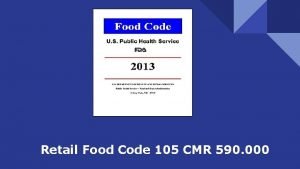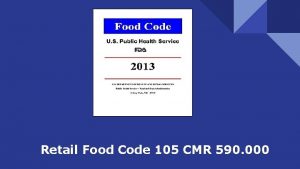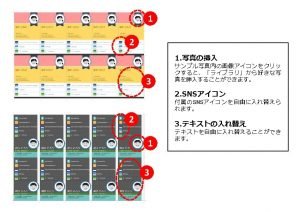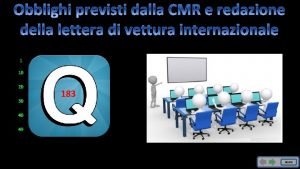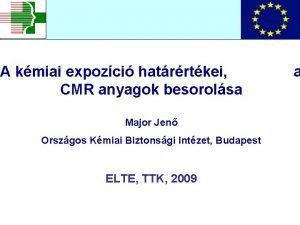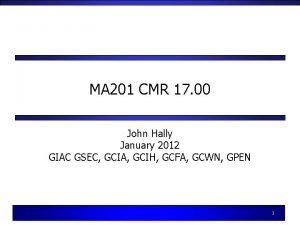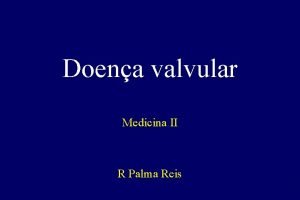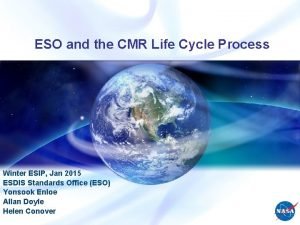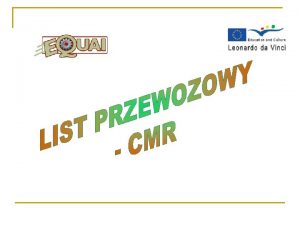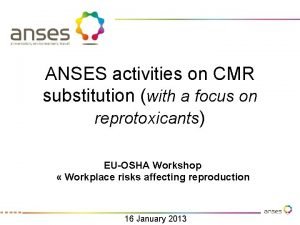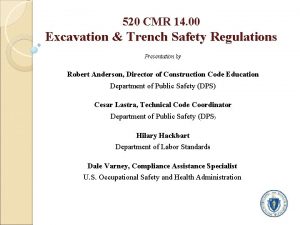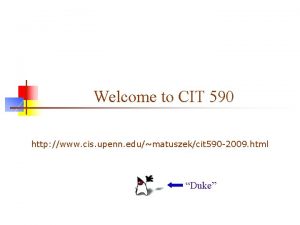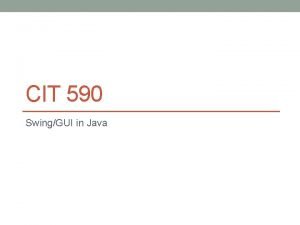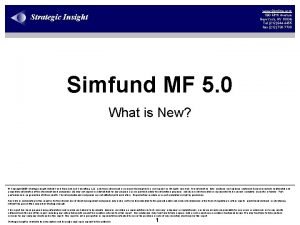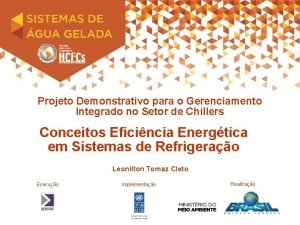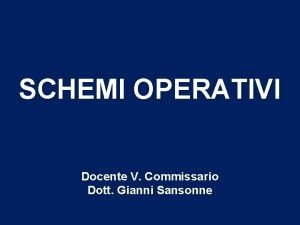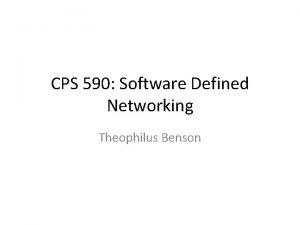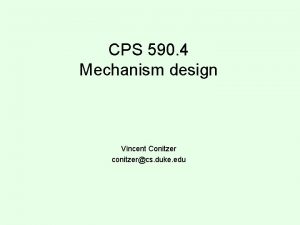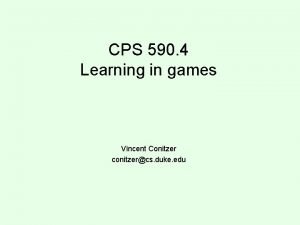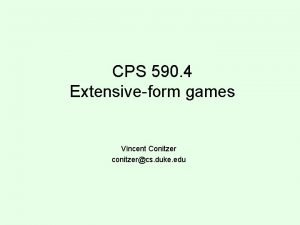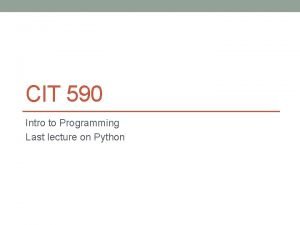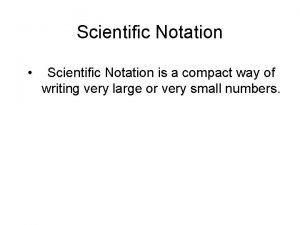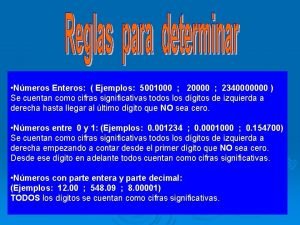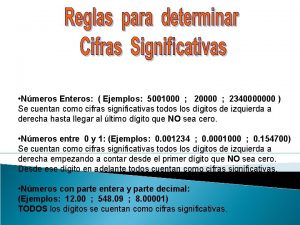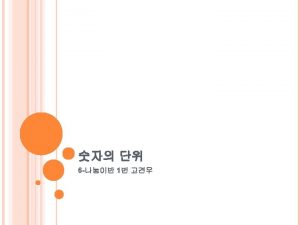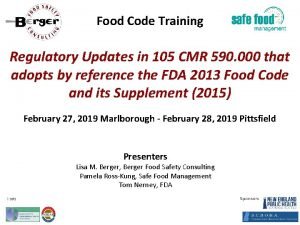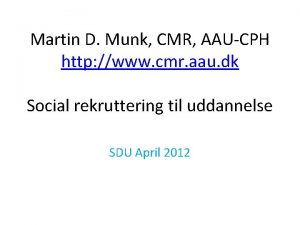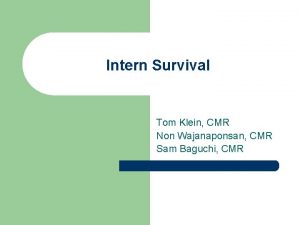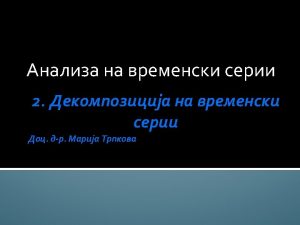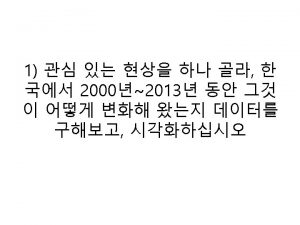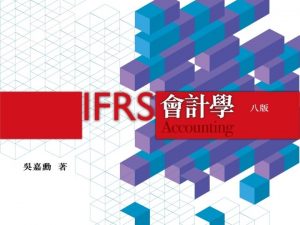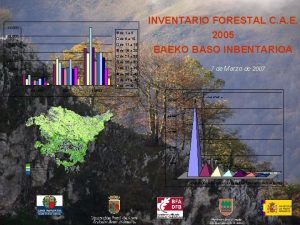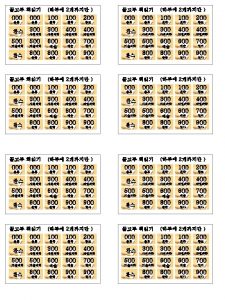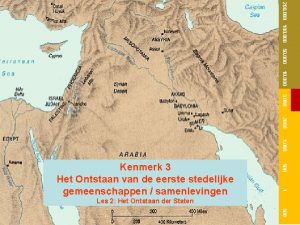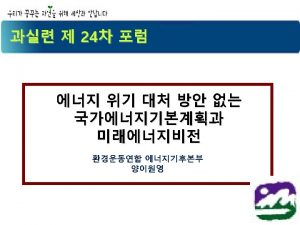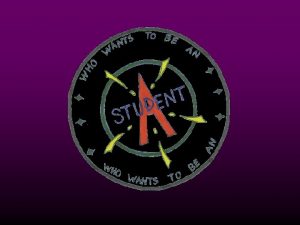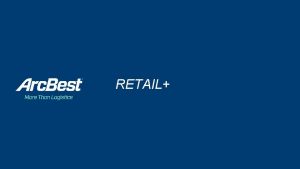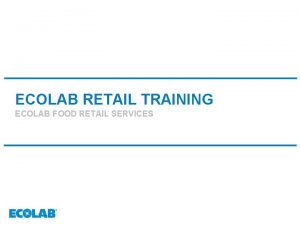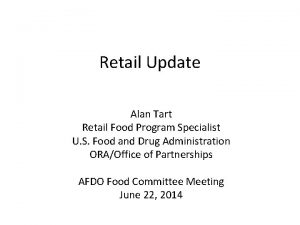Retail Food Code 105 CMR 590 000 Massachusetts













































- Slides: 45

Retail Food Code 105 CMR 590. 000

Massachusetts Department of Public Health Amended the Massachusetts State Sanitary Code 105 CMR 590. 000 By Adopting the 2013 Federal Food Code with 2015 Supplement 105 CMR 590. 000 and 2013 Federal Food Code or the Merged Food Code can be viewed at: https: //www. mass. gov/lists/retail-food Or purchased through the State Bookstore in Boston at (617) 727 -2834.

Objectives ● Significant changes from 1999 to the 2013 Federal Food Code ● Change in Person in Charge (PIC) Responsibilities ● Examples of violations and risks ● Inspection Form features ● Inspection Approaches

2013 Food Code Recognizes CDC 5 risk factors, leading cause of foodborne illness. ● Poor personal hygiene ● Unsafe food sources ● Improper cooking temps ● Improper holding temps ● Contaminated equipment Emphasis is on. Active Managerial Control Establish Procedures Train staff Monitor Verify staff following procedures 5. Verify procedures are effective 1. 2. 3. 4.

Definition Changes Time/Temperature Controlled for Safety (TCS) formally potentially hazardous foods (PHF’s) TCS foodsrequire temperature controls to limit pathogenic microorganisms or toxin formation Added TCS foods: ● Cut leafy greens ● Cut melon ● Cut tomato

Highly Susceptible Population ● Children age 9 or under in school, daycare or similar facility are included in a HSP

When You Review the 2013 Regulations look for…. . Better Identification of Risk Controls Former use of “critical” and “non critical” replaced with: ● Priority Item (P) ● Priority Foundation Item (Pf) ● Core Item Emphasis on Temperatures and Cleaning & Sanitizing ● Food contact surfaces ● Non food contact surfaces

Priority Items(P) (Eliminates, prevents, reduces risk to acceptable level) Examples 3 -302 -11 Packaged and unpackaged food separation, segregation 3 -302 -15 Washing Fruits and Vegetables - devices and chemicals used in compliance with manufacturer's instructions. 3 -301. 11 No bare hand contact with RTE foods 3 -304 -15(a) Glove use - single task 3 -501. 14 Cooling, Time and Temperature 4 -501. 114 Chemical Sanitizers, temperature of water, p. H, concentration and water hardness

Priority Foundation Items (Pf) (Supports or facilitates a Priority Item) Examples 3 -202 -18 Shellstock identification 3 -301. 11 Employees shall minimize bare hand arm contact with exposed food that is not in a ready to eat form. 3 -501. 15 Cooling Methods 4 -203 -11 Food Thermometers available and accurate 4 -302 -14 Sanitizing Solution, Testing Devices 6 -301 Soap & paper towels available at handsink

Core Items (general sanitation, facility structure, equipment design & general maintenance) Examples 3 -302 -12 Food Storage Containers identified with Common Name of Food 3 -304 -14 Wiping Cloths, Use Limitation, clean, dry, wet in sanitizing solution 3 -304 -15(b)(c)(d) Gloves, use Limitation

Chapter 2 Management and Personnel

The Person in Charge (PIC) ● Assigned and present during all operating hours. ● Knowledgeable of duties (handout) ● Responsible for direct supervision and management of food preparation and service *The Primary PIC is a certified Food Protection Manager and responsible for training all other PIC. How many PIC do you need to cover your operating hours?

2 -103 -11 Person in Charge Duties ● (F) Employees are verifying that FOODS delivered during non-operating hours are from approved sources, placed into appropriate storage locations, temperatures maintained, protected from contamination and unadulterated. ● (I) Employees are properly maintaining food temperatures during hot and cold holding. (use calibrated food thermometer to check temperatures) ● (N) Employees are trained in food safety, including allergy awareness, as it relates to their assigned duties. ● (O) Requires verified method for employees to report illness and relative health status. (Employee Reporting Agreement)

2 -201. 13 Exclusion & Restriction Employee diagnosed with Norovirus may return to work: ● With Doctors note or. . ● After symptoms of vomiting or diarrhea resolved, and more than 72 hours have passed since the employee became asymptomatic.

2 -501. 11 (Pf) Clean-up Diarrhea & Vomit Establishment must have procedures in place for clean up of vomiting and diarrheal events. A Food Establishment shall have “procedures to address specific actions employees must take to minimize the spread of contamination and exposure of employees, consumers, food and surfaces from vomitus or fecal matter. ”

Examplesof Clean-up Diarrhea & Vomit Procedures *Post instructions, train staff on clean-up procedures.

Chapter 3 FOOD

3 -203. 12 Shellstock Tags ● Date the last shellstock from the container is sold shall be recorded on the tag or label. (Pf) on Sold 8 /1 11/2

Kids Menu 3 -401 -11 ● Ground meat – must be fully cooked (beef, pork, lamb and other meats) ● All other undercooked foods are allowed with a consumer advisory. Fully Cooked (155°F)

3 -304 -14 Wiping Cloth, Use and Limitations Wiping cloths stored in sanitizing buckets, stored off floor (core)

If you make fresh juice…… 3 -404 -11(P) Treating Juices Packaged juice shall be: (a)Treated under a HACCP plan to attain a 5 -log reduction of most resistant microorganism of public health significance (b)Labeled if not treated to attain 5 -log reduction

If you purchase ROP frozen fish. . . 3 -501. 13(e) Thawing ROP Fish (core) ● Refrigeration Method - remove from package prior to thawing in refrigerator. ● Running Water or Microwave Method - remove from package before or immediately after thawing.

3 -501. 17 (Pf) Date Marking Foods ● Prepared and commercially prepackaged TCS foods held for more than 24 hours require a USE-by Date. ● Maximum of 7 days refrigerated storage *(Day 1 is preparation date) ● Cannot exceed manufacturer’s date!

New Temperature Danger Zone 41°F - 135°F 3 -501. 14 (P) Cooling 135 F – 70 F within 2 hours 3 -501. 16 (P) Hot Holding reduced to 135°F 3 -501. 19 (P) Time as a Public Health Control 3. 403. 11 (P) Reheating commercially processed TCS foods.

Written Procedures Specific to Food Process Contact the Health Office to discuss requirements if these apply to your establishment Non-Continuous Cooking • Requires prior approval from Health Office. Submit written procedure. • Written Procedure to include: How requirements will be monitored and documented. What corrective actions will be taken when requirements are not met.

3. 501. 19(b)Time as a Public Health Control Hot or Cold Foods may be held at room temperature for 4 hours. Cold Foods may be held at room temperature for 6 hours. ● Food is 41 F or 135 F at start (P) ● Foods marked with time removed from temperature controls & discard time not to exceed 4 hours. (Pf) ● Discard Food - in unmarked containers, or marked to exceed 4 hours. (P) Food is 41 F at start (P) ● Monitor to ensure food does not exceed 70°F within 6 hour holding. (Pf) ● Foods marked with time removed from temperature controls & discard time (Pf) ● Discard Food - in unmarked containers, or marked to exceed 6 hours, or above 70°F. (P) ●

TPHC - Monitoring Methods ● Log ● Label ● Wax Pencil

3 -502 -11 Special Processes(Pf) Variance needed: 1. 2. 3. 4. Smoking as means of preserving Curing Acidification -render food non TCS Packaging TCS foods using reduced oxygen packaging 5. Raw sprouts production (new!) 6. Custom processing animals for personal use 7. Mollusk tank (mussels, clams, oysters, scallops, abalone) 8. Preparing food by other means that is determined by the regulatory authority to require a variance.

3 -801. 11 Foods for Highly Susceptible Population (HSP) ● Unpasteurizedjuice is not allowed. ● Prepackagedjuice requires 5 log reduction or HACCP and variance. ● Fresh made juice (by the glass)for service or sale requires HACCP. ● Time as Public Health Control (TPHC) cannot be used for raw eggs.

Chapter 4 Equipment, Utensils & Linens

4 -302 -13(b) Mechanical Warewashers (Pf) Hi- Temp Mechanical warewashers must have an irreversible registering temperature indicator for measuring the utensil surface temperature. T-sticks

Additional Examples: Irreversible Temperature Indicators Ecolab Premium 160 F/170 F/180 F Dishwasher Labels Dishtemp by Thermoworks

4 -302 -13 Temperature Measuring Devices, Manual Warewashing 3 Bay Sink A thermometer shall be readily accessible to monitor wash and sanitizing water temperatures. Wash Water – 110°F minimum Sanitizing Water – per manufacturer’s instructions

Inspections

Inspectors will indicate one of the notations below for each risk factor or intervention on the inspection form. IN OUT NA NO COS R Sample Inspection Form In compliance Out of compliance Not applicable Not observed Corrected on site Repeat violation

Inspectors are to verify “Priority Item” (P) violations are corrected during the inspection.

8. 405 -11 Time Frame for Corrections ● Priority Item (P) Corrected at time of inspection. The Regulatory Authority may allow up to 72 hours for items not feasible to correct immediately. ● Priority Foundation Item (Pf) Corrected at time of inspection. The Regulatory Authority may allow up to 10 calendars days. ● Ipswich Re-inspections – no change in policy – 10 day re-inspection.

8. 304 -11 Public Notice of Inspections Food establishment must notify customers that: ● Most recent inspection report is available to public for review. ● By posting a sign or placard in conspicuous location

Sample Notice A copy of the most recent Ipswich Public Health Department Food Inspection Report is available to interested parties upon request. Please see the Manager. **Post in conspicuous location. Print is large enough for customer to read.

Let’s Review

PIC - Written Procedures All Food Establishments: 1. Vomit and Diarrheal Clean-up 2. Employees are “informed in a verifiable method of their responsibility to report to the PIC their health and activities relating to foodborne illness. Specific to the Food Process: 1. TPHC -Time in place of Temperature 2. Non-Continuous Cooking

New Required Tools ● Vomit and Diarrheal Clean-up Kit ● Irreversible registering temperature indicator for mechanical warewashers ● Thermometer at 3 bay sink ● Inspection Report Notice ● Method for date marking

Active Managerial Control Be Proactive! Priority and priority foundations are to be corrected during the inspection and documented on the report form. Train your Person in Charge (PIC)! Monitor as often as needed in your establishment! ● Food Temperatures ● Sanitizer concentrations and water temperatures ● Wash water temperature

Active Managerial Control continued Review the code Review your food processes. Review past inspection reports - most common violations? What procedures or training will result in better control and fewer violations? ● Obtain and organize resource material ● ● Train Staff and Implement Procedures! Monitor and Adjust or Re-train!

Thank you for your time! Please contact the Public Health Office with your questions. 978 -356 -6606 colleenf@ipswichma. gov
 97 000 in scientific notation
97 000 in scientific notation Express 602200 in scientific notation.
Express 602200 in scientific notation. 105 cmr 590
105 cmr 590 7 500 000 000 000 000 000 in scientific notation
7 500 000 000 000 000 000 in scientific notation Massachusetts food code
Massachusetts food code 0,000 0,000 0,000
0,000 0,000 0,000 Retail communication mix pdf
Retail communication mix pdf Organizational chart for retail business
Organizational chart for retail business Busceral
Busceral Nella cmr la presa in carico è un atto complesso
Nella cmr la presa in carico è un atto complesso Cmr anyagok
Cmr anyagok Ma 201 cmr 17
Ma 201 cmr 17 Cmr surgical
Cmr surgical Cmr
Cmr Eso
Eso List przewozowy doc
List przewozowy doc China market research group
China market research group Substitution cmr
Substitution cmr Excavation cmr
Excavation cmr Blue letter bible app
Blue letter bible app Cis upenn courses
Cis upenn courses Toefl level 2
Toefl level 2 The medieval church (590-1517 ce)
The medieval church (590-1517 ce) 590 ad
590 ad Java 590
Java 590 Sionline.com
Sionline.com Ahri 550/590
Ahri 550/590 Gianni sansonne
Gianni sansonne 590 ad
590 ad Cps 590
Cps 590 Cps590
Cps590 Cps 590
Cps 590 Cps 590
Cps 590 Cps 590
Cps 590 Conitzer
Conitzer Cit 590
Cit 590 Purdue aae 590
Purdue aae 590 Unit 2 food food food
Unit 2 food food food Sequence of food chain
Sequence of food chain Express 4,980,000, 000 in scientific notation.
Express 4,980,000, 000 in scientific notation. How to do scientific notation
How to do scientific notation 2,340,000,000
2,340,000,000 2,340,000,000
2,340,000,000 110 000 110 & 111 000 111
110 000 110 & 111 000 111 100000000/1000
100000000/1000 Scientific notation advantages
Scientific notation advantages


